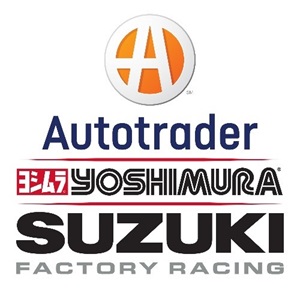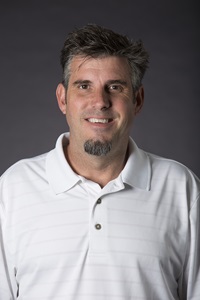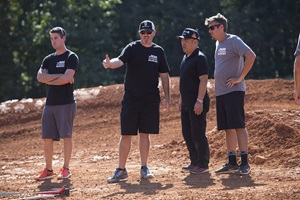Autotrader/Yoshimura/Suzuki Factory Racing Team Spotlight: Jeremy Albrecht
December 27, 2017

Jeremy Albrecht has learned the recipe for success. According to “J-Bone,” who has earned 11 major titles as a tuner, eight AMA Mechanic of the Year awards, the 2006 Mechanix Wear Outstanding Achievement award and has been the JGRMX team manager since its inception, success comes by working hard and being honest. That is sage advice from an industry professional.
The Autotrader/Yoshimura/Suzuki Factory Racing Team is rolling into the Anaheim Supercross opener with a dozen new employees, a four-rider 250 effort, and high expectations. We sat down with Jeremy Albrecht to find out about the evolution of the JGRMX program, Suzuki’s involvement, the rider selection process, and what’s to come in 2018 and beyond.

Jeremy, can you believe it has been ten years since the JGRMX race team began?
In some ways I don’t, while in other ways I do. Some days I feel like we just started the team, and other days it seems like we’ve been working at it forever. These ten years have gone by quickly.
What has been the biggest team change in the past ten years?
This year has really been a major change, because now we’re fielding both a 450 and a 250 team. There are six of us that have been here since the start. In those ten years we’ve added staff. The bikes change all of the time. We’re always trying to stay ahead of everything so that we’re prepared and ready to do our best.
When you, owner Coy Gibbs and David Evans launched the race team at the beginning of 2008 did you guys ever discuss the possibility of fielding a 250 team?
Originally we talked about having 450, 250 and amateur teams. Coy had this big dream where we were going to have the race shop on our own property. Once we started racing we didn’t get the 450 program to where we wanted it, so we didn’t want to take on the 250 effort. In 2017, we helped Yoshimura with Suzuki’s 250 program, and we fielded the riders out of our truck. That made us realize how much the 250 would help our team. We decided to do the whole thing, and Suzuki was willing to let us be their 250 factory team. I feel like it’s going to help us long-term with the riders. Obviously, there’s more to take care of and do to raise money, but it’s going to be good. I’m happy that things happened this way, even if it was by surprise. We have a three-year deal to run the 250 and 450 program for Suzuki. We’re going to grow it and make things better. That’s the plan.
One of the many interesting components of the team is that when it started Coy made the riders live and train in North Carolina. That rule went away after a few years. Now, ten years later, the team riders have actually decided to reside in the Charlotte area.
Yeah, Weston Peick bought a place not far from the shop. Justin Hill bought a house. Phil Nicoletti and Kyle Peters are living together, and Jimmy Decotis is moving to North Carolina in the next month or so. I’m really happy with how the team is going right now, because everyone on the team is gelling and wanting to work together. Coy spent a lot of money to make sure the riders had everything they need to perform. Sure, we could lease a track, and that’s what we did at the beginning. Then we discovered that it was difficult to keep the track the way that we wanted it. Coy was thinking about purchasing two water trucks, but really the only way to make the track good was to put a sprinkler system in. There was no point in doing that on leased property, so we bought land. Coy built a shop on the property, and we put a sprinkler system in. Now, the track gets watered every night, whether we’re there or not. That way the same ruts and bumps are there if we want to leave them. In the past we would come back from the races and the track was hammered. In order to make it good again we had to rip up the dirt and make it smooth. That was counter-productive, because those guys don’t ride smooth race tracks. The only way to have a really good track is to have 100 people come ride, which we’re not going to do. Now we can get some ruts and bumps formed, and those things can remain because of our watering system. Last year was the best we had with the outdoor track. It should be cool now that our riders are here and want to take advantage of the facility. There’s a gym at the NASCAR shop, and we have a physical therapist. We’re all here, so if the riders have a problem we’ll be able to help them. If I was a rider I would live here. At the beginning, when we made them live in North Carolina, the guys fought it. Now we’re not making anyone live here, but the riders are coming here on their own. Coy definitely likes that. He always has, and that’s because he grew up doing team sports. This year is more like how we wanted it to be at the beginning.
You have a lot of responsibilities as the team manager. What occupies most of your time?
The phone [laughter]. I walk about five miles a day in the parking lot outside the shop while I’m talking on the phone. I have calls with the riders, sponsors and staff who aren’t in North Carolina. I also spend a lot of time on emails. It’s hard to keep up with, but I try. I’m always trying to plan ahead and work with sponsors so they remain committed to the program. Now, with more riders, I talk to all of them quite a bit. I wish I could say that they were always happy, but there are little issues that we work on. It’s nothing we can’t handle. I did get some help this year, so hopefully it won’t be as crazy. It was a little easier when Coy was working fully on the motocross side, because he could help me with various tasks. Everyone always wants to talk to the boss anyway. I go over to the Cup shop and talk to Coy so that he’s involved. I do like that my job changes all of the time. That’s why I go outside and walk around while I’m talking on the phone. I can’t sit at a desk all day long. I wouldn’t change my job for anything.
You brought up how Coy assumed responsibilities at the JGR Cup side, which he began nearly two years ago. How has the team dynamic changed since then?
It’s similar in some ways, but harder in others. It was nice to walk to the next office and get answers from him right away. He’s really good at giving you his answer right away. He doesn’t waver. He’s really smart, and he knows what he wants. Coy was also very helpful at the races. He would talk with the sponsors when they came to the rig. That has been my toughest challenge, because at the races I’m juggling different things. Coy also did some video filming of the riders, which was a big help. Really, it was having another person at the races who cares. The one thing we don’t do here are job descriptions. We do what needs to be done. If a job isn’t getting done, then someone else should step in and help. Coy helped with everything. At the start of the team Coy told me that he would never help with the tent, because that’s what he had to do in drag racing. Then he was the first person to help with the tent, and he did it every single time. I don’t even know why he told me he wouldn’t do it, because he did it the most! In racing we normally get one day off a week, but he was still at the shop on his days off. He works the hardest. It’s hard to point to one specific thing that he did and what we’re missing, because he did everything. Now he’s doing a good job over the on Cup side. That part of the business is obviously very important for the family, and it’s also important for us. Coy is still involved with the motocross team as much as he can be, and he’ll be at Anaheim. Hopefully we can make him proud.
The lead up to Anaheim 1 is probably the most exciting time of the year, but a close second might be late in the season when contract talks start happening. Was it difficult to choose the team riders for 2018?
It’s always hard. I made a list and we talked about it with Suzuki, Coy, and David Evans. Sometimes there are riders we want that don’t end up working out, and then there are guys you end up signing that you weren’t thinking about. In the end, this team is really close to who we were wanting. It’s hard during contract negotiations. You don’t know if the rider really wants to be here, or whether they’re trying to get their salary to go up at the team they want to be at. That’s always tricky. You don’t want to get too involved unless you know for a fact that they want to ride for you. It’s especially hard for riders who employ agents. Usually if you’re talking to the rider you can get a feel for what they want to do. When going through an agent you’re not sure what the rider is thinking. A lot of the guys that we signed this year don’t have agents, so it made things easy. I could tell that they really want to be here. We didn’t just throw money at them. We worked out a deal with each rider that was fair for all of us. We’re hoping that we did pick the right guys. Back to the question, it’s always hard to pick riders. You can only pick a few riders. There were other good guys out there that we didn’t sign for 2018. I felt like we picked the guys that we have right now for reasons that we needed as a team. I’m hoping that we can get the results that we need.
When you started wrenching for your brother all those years ago did you ever imagine that you would end up running a race team in North Carolina?
No, I never thought that. When I started working for my brother I was also racing. Being a mechanic kind of happened on accident, just like most things do. If you work hard and are in the right place at the right time you usually catch a break. Randy Lawrence was my brother’s mechanic. Then my brother ruptured his spleen at the first race, so Randy went to temporarily work for Doug Dubach. When my brother was back racing Randy didn’t want to do it anymore, so my brother asked me to wrench for him. I was not a mechanic at the time. I worked on my own bike, but I couldn’t be considered a mechanic. I knew an old factory mechanic by the name of Randy Bruninga who worked for a friend of mine. I asked Randy if he could teach me how to be a mechanic. I tried really hard to do a good job, because I wanted to make sure that I wouldn’t hurt my brother. I wasn’t doing it because I wanted to do it, but rather to help my brother. Things snowballed from there. It’s funny, my second mechanic job was for Buddy Antunez, who is now working for the team. Buddy and I have been friends since I was 12 years old. Then I started working for Jeff Emig, who was another friend of mine. I feel like things will work out if you’re an honest person and you work hard. I never planned to be a factory mechanic, so to now be running two teams is pretty awesome. I’m going to keep working hard.
How has Suzuki’s involvement with the race team changed the structure and operation of JGRMX?
It has changed a lot for the better. It’s hard to do it all on your own. That’s why our team is so big for 2018. The more heads you have together the better you are. The Suzuki staff, such as the engineers in Japan, are helping us and making a big difference. This is the most involvement we’ve ever had with engineers. They’re coming to the U.S. for the start of the Supercross series. This is the most testing we’ve done with a manufacturer–from the chassis engineers to the engine engineers and the head of racing. It’s cool to be a part of it at this level. We’ve had a team for a long time, and every year things get better. This is definitely the best year and most support we’ve ever had. Last year Suzuki put their support in RCH Racing, and we were doing things pretty close to on our own. This year we have a lot of help. Really, it’s more the behind the scenes stuff that they help the most with.
People make a big deal out of works parts. For 2018, the team has access to a plethora of trick components. Are works parts a vital part to success?
We’ve had works parts before. Those aren’t really the things you need as much. We can make parts in-house, so they’re not the biggest piece of the puzzle. It’s more the people behind it that are helping us know what the parts are, being involved in making better parts, and planning for the future. Everyone thinks that factory parts make all of the difference in the world. Factory components are a small piece of the big picture. We’re happy to get the parts, but people are more important than the parts.
The team is staying in California after the Anaheim 1 Supercross opener. Why?
We’re staying in California because we have the engineers coming from Japan. That way, if we need to work on anything, they can be involved and help. We’ll have meetings and do some testing. It will be good for them to know our riders more and understand what the needs are for the future. Like I said, we’re doing this for three years, and we want to do the best job that we can. We need to put Suzuki back where they belong.

For more team news and information, please visit www.jgrmxraceteam.com. Next week we will conclude the Autotrader/Yoshimura/Suzuki Factory Racing Team spotlight with the owner of JGRMX, Coy Gibbs.
Back to News